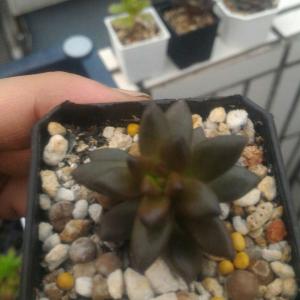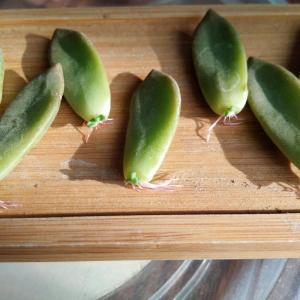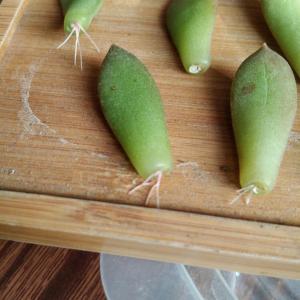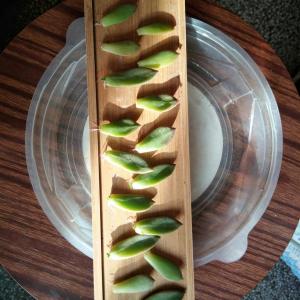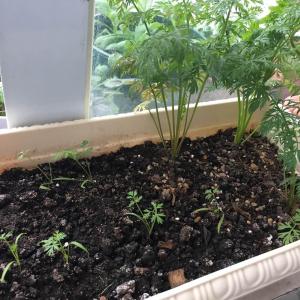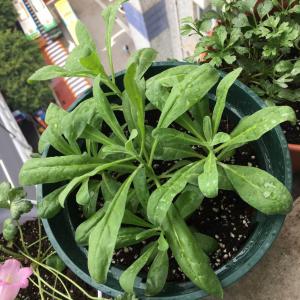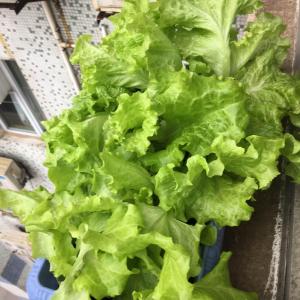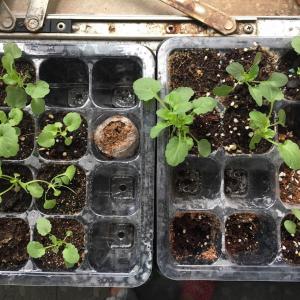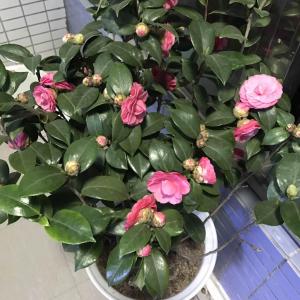Aki
2018年01月12日

Got this Anchan or butterfly pea flower seeds from my nephew, the progress of growing from seed on 10 Jan - 12 Jan
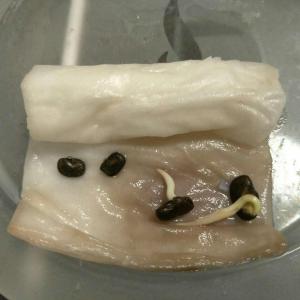
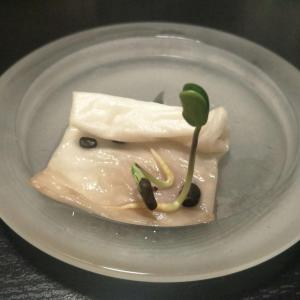


0
0
文章
Miss Chen
2018年01月12日

Description: This herbaceous perennial wildflower is 4-10" tall and more or less erect. A small rosette of basal leaves may be produced, but it withers away before the flowers bloom. The margins of these basal leaves, when present, are hairless. Multiple flowering stems are produced that often branch. These stems are light to medium green, 4-angled, and either hairless or slightly hairy along their angled margins. Pairs of opposite leaves occur at intervals along each stem. These leaves are about ½–1" long and less than ¼" across; they are medium green, lanceolate-oblong or linear-lanceolate, smooth or ciliate along their margins, and single-veined. Secondary leafy stems often develop from the axils of the opposite leaves along the primary stem.

The upper stems terminate in small flat-headed clusters of flowers. Individual flowers are about ¼" across, consisting of a tubular corolla with 4 spreading lobes and a green calyx with 4 linear-lanceolate teeth. The color of the corolla can vary from pale purplish pink to white; there are conspicuous hairs along its throat. The flowers of Long-Leaved Bluets are dimorphic: some flowers have long fertile styles and short aborted stamens, while other flowers have short aborted styles and long fertile stamens. Each fertile style has a pair of flattened stigmata at its apex. The blooming period occurs from late spring to mid-summer and lasts about a month. The flowers are replaced by globoid 2-celled seed capsules that are a little shorter than the teeth of their calyces. Each cell of a seed capsule contains several small seeds. The root system consists of a small crown with long fibrous roots underneath. This wildflower spreads into new areas by reseeding itself.
Cultivation: The preference is full or partial sun, mesic to dry conditions, and a rather sterile soil that is rocky or gravelly. This species will adapt to rock gardens and it is not difficult to cultivate.
Range & Habitat: The native Long-Leaved Bluets occurs occasionally in northern and southern Illinois, while in the central section of the state it is largely absent (see Distribution Map). Habitats include dry gravel prairies, hill prairies, rocky glades, and rocky upland woodlands. This wildflower is normally found in high quality natural areas.
Faunal Associations: The flowers are pollinated primarily by small bees, including Halictid bees (Lasioglossum spp., Halictus spp., etc.), masked bees (Hylaeus spp.), little carpenter bees (Ceratina spp.), and mason bees (Hoplitis spp.). These insects suck nectar and collect pollen from the flowers. The caterpillars of a small moth, Thyris maculata (Spotted Thyris), feed on the leaves of Houstonia spp. (Bluets). The foliage is not known to be toxic, therefore it may be eaten occasionally by the Cottontail Rabbit and other mammalian herbivores.
Photographic Location: The wildflower garden of the webmaster in Urbana, Illinois.
Comments: This is a dainty plant that produces abundant small flowers if it receives some sunlight. Long-Leaved Bluets is smaller in size than Houstonia purpurea (Broad-Leaved Bluets), but larger in size than several other bluets, including Houstonia caerulea (Quaker Ladies) and Houstonia pusilla (Small Bluets). Long-Leaved Bluets is very similar in appearance to Houstonia canadensis (Canada Bluets); some authorities consider the latter species to be a variety of the former, or Houstonia longifolia ciliata. Canada Bluets is supposed to have more persistent basal leaves with ciliate margins, flowering stems that are fewer in number and less branched, and slightly longer corolla lobes. Because the ranges of these two species overlap and they may intergrade, it is not always possible to reliably assign field specimens to one species or another. A scientific synonym of Long-Leaved Bluets is Hedyotis longifolia.

The upper stems terminate in small flat-headed clusters of flowers. Individual flowers are about ¼" across, consisting of a tubular corolla with 4 spreading lobes and a green calyx with 4 linear-lanceolate teeth. The color of the corolla can vary from pale purplish pink to white; there are conspicuous hairs along its throat. The flowers of Long-Leaved Bluets are dimorphic: some flowers have long fertile styles and short aborted stamens, while other flowers have short aborted styles and long fertile stamens. Each fertile style has a pair of flattened stigmata at its apex. The blooming period occurs from late spring to mid-summer and lasts about a month. The flowers are replaced by globoid 2-celled seed capsules that are a little shorter than the teeth of their calyces. Each cell of a seed capsule contains several small seeds. The root system consists of a small crown with long fibrous roots underneath. This wildflower spreads into new areas by reseeding itself.
Cultivation: The preference is full or partial sun, mesic to dry conditions, and a rather sterile soil that is rocky or gravelly. This species will adapt to rock gardens and it is not difficult to cultivate.
Range & Habitat: The native Long-Leaved Bluets occurs occasionally in northern and southern Illinois, while in the central section of the state it is largely absent (see Distribution Map). Habitats include dry gravel prairies, hill prairies, rocky glades, and rocky upland woodlands. This wildflower is normally found in high quality natural areas.
Faunal Associations: The flowers are pollinated primarily by small bees, including Halictid bees (Lasioglossum spp., Halictus spp., etc.), masked bees (Hylaeus spp.), little carpenter bees (Ceratina spp.), and mason bees (Hoplitis spp.). These insects suck nectar and collect pollen from the flowers. The caterpillars of a small moth, Thyris maculata (Spotted Thyris), feed on the leaves of Houstonia spp. (Bluets). The foliage is not known to be toxic, therefore it may be eaten occasionally by the Cottontail Rabbit and other mammalian herbivores.
Photographic Location: The wildflower garden of the webmaster in Urbana, Illinois.
Comments: This is a dainty plant that produces abundant small flowers if it receives some sunlight. Long-Leaved Bluets is smaller in size than Houstonia purpurea (Broad-Leaved Bluets), but larger in size than several other bluets, including Houstonia caerulea (Quaker Ladies) and Houstonia pusilla (Small Bluets). Long-Leaved Bluets is very similar in appearance to Houstonia canadensis (Canada Bluets); some authorities consider the latter species to be a variety of the former, or Houstonia longifolia ciliata. Canada Bluets is supposed to have more persistent basal leaves with ciliate margins, flowering stems that are fewer in number and less branched, and slightly longer corolla lobes. Because the ranges of these two species overlap and they may intergrade, it is not always possible to reliably assign field specimens to one species or another. A scientific synonym of Long-Leaved Bluets is Hedyotis longifolia.
0
0
文章
Miss Chen
2018年01月10日


耐阴植物是指在光照条件好的地方生长好,但也能耐受适当的荫蔽,或者在生育期间需要较轻度的遮阴的植物。对光的需要介于阳生和阴生植物之间,它们所需的最小光量约为全光照的1/15-1/10。
耐阴植物在形态和生态上的可塑性很大,也介于上述两类型之间。如树木中的青岗属、山毛榉、云杉、侧柏、胡桃等;药材植物中的桔梗、党参、沙参、黄精、肉桂、金鸡纳等。耐阴植物同其他植物一样有调节环境温度、湿度、吸附消化有害气体和灰尘、净化空气、平衡空气中氧气和二氧化碳含量等多种功能;同时它弥补了其他植物的缺陷,能在阳光很少的区域、阴湿的环境中良好生长,起到良好的水土保持作用。
如果你想要栽种一些特别耐阴的植物,下面这些就很适合你,无论是种院子还是室内,这8种不同类型的植物也一定能够满足你的需求,不需要光照也能生长,新手也能养活。

1、矾根
它是一种多年生的宿根植物,喜欢温暖湿润的环境,现在有的地方都用它来绿化,花色是非常优美的。
养在室内要注意保持一定的环境湿度,它不喜欢干燥,养护要多喷水,土壤干了就需要浇水,养在阳台就要注意避免暴晒。
2、荷包牡丹
荷包牡丹很适合栽种在通风和遮阴的角落,给予疏松和排水良好的土壤,避免盆土积水,不要让阳光直射或暴晒,它就能保持生长了。值得注意的是,荷包牡丹的耐寒性比较好,在北方的院子养护起来也是比较可行的。
3、观赏蕨类植物
如果室内有阴凉潮湿的地方,那么栽种蕨类植物就是不错的选择,常见的鸟巢蕨、铁线蕨、珊瑚蕨和凤尾蕨等,它们的植株小巧,耐阴,喜欢湿润的环境,保持湿度和温暖,它们就能保持良好的生长了。
4、冷水花
它们一般都是生长在树荫下,盆栽养在室内也是完全可行的,非常小巧的观叶植物,养护比较简单,保持环境一定的环境湿度,给予疏松和排水良好的土壤,加上温暖遮阴的环境,就可以让它长得油光华亮了。
5、猫眼草
这是一种很特别的小草,有时候会野生在院子里,它是一种可以入药的植物,正式名叫大戟,不能误食,一般是不作为盆栽养护的,不过它的长相非常别致,可以作为庭院的装饰植物。
6、玉簪
玉簪的名字很好听,是因为它开花的时候,花朵很像古代女子头上的玉簪,它也会是很好养护的盆栽植物,养护需要排水良好的土壤,环境保持温暖微润即可,它喜欢阴凉的环境,长在光线明亮处也能开花,花朵还带着迷人的香味呢。
7、铃兰
铃兰是一种适合生长在树荫下的植物,在阴凉处生长特别好,喜欢疏松、肥沃、排水良好和富含腐殖质的土壤,养护需要保持通风和土壤微润就行了。
养护要注意避免暴晒和高温,冬季避免受冻,也要记住不要和水仙花种一起,不然会两败俱伤。
8、菖蒲(金钱蒲)
这是一种多年生的草本植物,喜欢生长在潮湿阴凉的水边和岩石上,是非常清新的观赏草,养护要保持较高的环境湿度,避免暴晒和受冻。
养护注意保持水分充足,保持环境湿度,作为盆景装饰植物也是非常棒的。
2
3
文章
Miss Chen
2018年01月09日

For gardeners new to spring bulbs, daffodils (Narcissus spp.) are a bright gift. Hardy between U.S. Department of Agriculture plant hardiness zones 3 through 10, depending on species, daffodils are less appetizing to winter grazing rodents -- and more reliable perennials -- than many other spring bulbs. They come in a variety of forms and coloration. A well-chosen collection of early-, mid- and late-season varieties will brighten your garden throughout the spring.

Mystery of the Bulb
Daffodil bulbs, like other tunicate bulbs, wear a protective layer of dried skin, or tunic, that helps insulate and keep bulbs moist. The thick layers underneath the tunic anchor this year's plant but also contain the embryo of a succeeding plant, flower and all, and enough nutritious material to keep it healthy until it is time for it to bloom, hopefully next spring. The bulb protects the growing flower from heat, drought and freezing weather.
The bulb never stops growing. It adds layers and processes and stores nutrients year-round. This prepares its hardy little occupant for the vicissitudes of unpredictable spring weather. It might even pop up through the last melting snow if conditions are right.
The Right Conditions
Every daffodil has its own rhythm to follow. Growth responds to daylight and soil temperature. Daffodils come to life when soil temperatures range from 50 to 60 degrees Fahrenheit and as the sun rises and days lengthen. Each year brings a slightly different progression, so bloom times may vary by days or weeks from one year to another.

Early varieties such as February Gold (Narcissus 'February Gold,' USDA zones 4 to 8) and Ice Follies (Narcissus 'Ice Follies,' USDA zones 3 to 8) bloom, as their names suggest, as winter fades into very early spring. Tete-a-Tete (Narcissus 'Tete-a-Tete,' USDA zones 4 to 8) may bloom as early as February in warmer southern zones, but wait until March further north.
Mid-season begins in March in southern zones, but in cooler zones Jack Snipe (Narcissus 'Jack Snipe,' USDA zones 4 to 8), Trevithian (Narcissus 'Trevithian,' USDA zones 5 to 10) and many of the big mid-season trumpet "daffs" bloom throughout April.
Late varieties such as Salome (Narcissus 'Salome,' USDA zones 3 to 9) may bloom as late as mid-May in the north.
About Chilling
Many daffodils depend on winter chilling to keep their bloom time on track. They typically require temperatures between 35 and 48 degrees Fahrenheit for 12 to 18 weeks depending on variety -- not a problem for bulbs planted in fall in northern zones. Gardeners in USDA zone 8 and further south dig and dry bulbs with long chilling requirements after foliage dies down in summer and keep them in cool storage for three to four months before replanting. Gardeners in warmer zones can plant native daffodils such as tazetta daffodils (Narcissus 'Minnow,' USDA zones 5 through 9) that do not require lengthy chilling.
The Prolific Perennial
Daffodils are reliably perennial and will produce daughter bulbs along their bases. Separate these bulbs every two or three years after their foliage has died down in early summer. Just lay bulbs out in cool shade to dry. Pull off the daughter bulbs and plant them in sunny, well-drained soil come fall.

Mystery of the Bulb
Daffodil bulbs, like other tunicate bulbs, wear a protective layer of dried skin, or tunic, that helps insulate and keep bulbs moist. The thick layers underneath the tunic anchor this year's plant but also contain the embryo of a succeeding plant, flower and all, and enough nutritious material to keep it healthy until it is time for it to bloom, hopefully next spring. The bulb protects the growing flower from heat, drought and freezing weather.
The bulb never stops growing. It adds layers and processes and stores nutrients year-round. This prepares its hardy little occupant for the vicissitudes of unpredictable spring weather. It might even pop up through the last melting snow if conditions are right.
The Right Conditions
Every daffodil has its own rhythm to follow. Growth responds to daylight and soil temperature. Daffodils come to life when soil temperatures range from 50 to 60 degrees Fahrenheit and as the sun rises and days lengthen. Each year brings a slightly different progression, so bloom times may vary by days or weeks from one year to another.

Early varieties such as February Gold (Narcissus 'February Gold,' USDA zones 4 to 8) and Ice Follies (Narcissus 'Ice Follies,' USDA zones 3 to 8) bloom, as their names suggest, as winter fades into very early spring. Tete-a-Tete (Narcissus 'Tete-a-Tete,' USDA zones 4 to 8) may bloom as early as February in warmer southern zones, but wait until March further north.
Mid-season begins in March in southern zones, but in cooler zones Jack Snipe (Narcissus 'Jack Snipe,' USDA zones 4 to 8), Trevithian (Narcissus 'Trevithian,' USDA zones 5 to 10) and many of the big mid-season trumpet "daffs" bloom throughout April.
Late varieties such as Salome (Narcissus 'Salome,' USDA zones 3 to 9) may bloom as late as mid-May in the north.
About Chilling
Many daffodils depend on winter chilling to keep their bloom time on track. They typically require temperatures between 35 and 48 degrees Fahrenheit for 12 to 18 weeks depending on variety -- not a problem for bulbs planted in fall in northern zones. Gardeners in USDA zone 8 and further south dig and dry bulbs with long chilling requirements after foliage dies down in summer and keep them in cool storage for three to four months before replanting. Gardeners in warmer zones can plant native daffodils such as tazetta daffodils (Narcissus 'Minnow,' USDA zones 5 through 9) that do not require lengthy chilling.
The Prolific Perennial
Daffodils are reliably perennial and will produce daughter bulbs along their bases. Separate these bulbs every two or three years after their foliage has died down in early summer. Just lay bulbs out in cool shade to dry. Pull off the daughter bulbs and plant them in sunny, well-drained soil come fall.
0
0
文章
Miss Chen
2018年01月07日

Gladiolus is an easy-to-grow flower noted for its tall flower spikes. The gladiolus or gladiola typically is grown in U.S. Department of Agriculture hardiness zones 7 through 10. Called the sword lily for its upright, flower-studded stalk, the gladiolus is a fair weather plant. The flower bulbs, also called corms, are not winter-hardy. The flowers bloom from mid-summer through the first frost.

Features
The gladiolus blooms on tall stems with narrow, blade-shaped leaves. Because glads mature in a season, you can plant corms in spring and enjoy flowers by mid-summer, when a series of trumpet-shaped florets opens along the stem. Plant the corms in well-drained, organic soil with moderate moisture. Encourage prolific blooms by planting gladioli away from shrubs or other tall flowers. The plants produce strong stems and healthier flowers with open exposure to sunlight. When the plants die back in late autumn, corms remain in the ground in temperate climates and put out new foliage and flowers in spring. Dig up corms in cold zones and store in a well-ventilated, protected area at 35 to 45 degrees Fahrenheit until spring.
Types
Glads range from miniatures, growing under 3 feet tall with 2-1/2-inch flowers, to giants, growing 4 to 6 feet tall with 5-inch blooms. Glads flower in almost every color shade from white through dark purple. Some cultivars yield bi-color flowers, such as white with brown centers. Other hybrids offer green flowers that blend with the tall leaves. Miniatures fit well as cut flowers in small bouquets. Glads make spectacular vase arrangements with or without other cut flowers.

Staking
Keep flowers upright by staking gladioli. In wind or rain, glads may topple, uprooting the bulbs. Flower weight makes some glad stems bend or break. Protect stems by staking each individually or staking a row of glads. Stake individual flowers by tapping a 1-inch square wood support into the ground and tying each stem to its stake. Support a row of glads by tapping in 2-inch square posts and weaving twine between the posts. Tie the glads to the twine network. Some gardeners plant rows of glads in front of lattice so that tipsy glads are easily anchored to the decorative lattice grid.
Considerations
Select cultivars that bloom at different times for an ever-changing summer display. By planting corms in succession every two weeks from spring through early summer, the glads bloom continuously into autumn. For variety, choose a different color or height for each planting.

Features
The gladiolus blooms on tall stems with narrow, blade-shaped leaves. Because glads mature in a season, you can plant corms in spring and enjoy flowers by mid-summer, when a series of trumpet-shaped florets opens along the stem. Plant the corms in well-drained, organic soil with moderate moisture. Encourage prolific blooms by planting gladioli away from shrubs or other tall flowers. The plants produce strong stems and healthier flowers with open exposure to sunlight. When the plants die back in late autumn, corms remain in the ground in temperate climates and put out new foliage and flowers in spring. Dig up corms in cold zones and store in a well-ventilated, protected area at 35 to 45 degrees Fahrenheit until spring.
Types
Glads range from miniatures, growing under 3 feet tall with 2-1/2-inch flowers, to giants, growing 4 to 6 feet tall with 5-inch blooms. Glads flower in almost every color shade from white through dark purple. Some cultivars yield bi-color flowers, such as white with brown centers. Other hybrids offer green flowers that blend with the tall leaves. Miniatures fit well as cut flowers in small bouquets. Glads make spectacular vase arrangements with or without other cut flowers.

Staking
Keep flowers upright by staking gladioli. In wind or rain, glads may topple, uprooting the bulbs. Flower weight makes some glad stems bend or break. Protect stems by staking each individually or staking a row of glads. Stake individual flowers by tapping a 1-inch square wood support into the ground and tying each stem to its stake. Support a row of glads by tapping in 2-inch square posts and weaving twine between the posts. Tie the glads to the twine network. Some gardeners plant rows of glads in front of lattice so that tipsy glads are easily anchored to the decorative lattice grid.
Considerations
Select cultivars that bloom at different times for an ever-changing summer display. By planting corms in succession every two weeks from spring through early summer, the glads bloom continuously into autumn. For variety, choose a different color or height for each planting.
0
0
文章
Miss Chen
2018年01月07日

Amaryllis (Hippeastrum spp.) produce flamboyant blooms over outsize bulbs. The tropical plants grow outdoors only in U.S. Department of Agriculture plant hardiness zones 8 through 10, but they also make a splash as houseplants where they brighten winter holidays. How many times they'll bloom indoors or how long they'll last in the garden depends on how you treat them after they're finished blooming.

The Perennial Bulb
Like other bulbs, the amaryllis nurtures next year's plant and bloom as this year's flowers fade. It is also perennial, which means that it lives for three years or longer. How many years your amaryllis lives depends on its ability to gather nutrients, a process fueled by photosynthesis in its leaves.
Unlike many bulbs, amaryllis leaves follow flowers and persist for several months after the plant has bloomed in the spring. Whether outdoors or in a container, do not cut the amaryllis plant's long, straplike leaves until they whither. In this way, you've given the perennial bulb another year of life.
Indoor Bulbs
Gift amaryllis bulbs typically arrive eight to 10 weeks before the winter holidays with instructions to begin watering them immediately. Depending on the age of the bulb, it will produce one or more scapes typically topped by three trumpet-shaped flowers in shades of red, pink, white or bicolor combinations. Indoors, with bright light and moderate temperatures, each scape of flowers lasts up to a month. Plants kept in a cool room, around 65 degrees Fahrenheit, bloom longest.

In the Garden
Plant amaryllis bulbs in the garden in September or October in USDA zones 8 through 10. Use purchased bulbs or gift bulbs that have faded. Plant the bulbs in organic, well-draining soil with the wide side down so that the narrow neck sits above the soil.
Beginning when scapes begin growing in February or March, fertilize with a low-nitrogen garden fertilizer such as 5-10-10 or 6-12-12. Work 1 to 1.5 pounds into the soil for every 100-foot of row or for 100 square feet of bed. Fertilize when the bulbs break dormancy, when scapes reach 6 to 8 inches tall and again after the flowers fade in April. Remove faded flower scapes to stop energy-robbing seed formation.
Bulbs and Dormancy
Whether indoors or out, the secret to long-lived amaryllis lies in their ability to build new embryos while their leaves fade throughout the summer. Dormancy allows them to rest before entering the "home stretch" of bloom. After this period of rapid growth, bulbs need a period of 2 to 3 months of dormancy. Stop watering plants and put potted bulbs in a cool, dry basement or plant them with garden bulbs in fall.
Begin watering plants again as they emerge from dormancy in February or March and keep the soil evenly moist as bulbs bloom. Within two to three years, bulbs may produce offsets -- bulblets that, when removed during dormancy and planted in pots or garden, may produce flowers within three to four years, prolonging the bloom of your amaryllis collection.

The Perennial Bulb
Like other bulbs, the amaryllis nurtures next year's plant and bloom as this year's flowers fade. It is also perennial, which means that it lives for three years or longer. How many years your amaryllis lives depends on its ability to gather nutrients, a process fueled by photosynthesis in its leaves.
Unlike many bulbs, amaryllis leaves follow flowers and persist for several months after the plant has bloomed in the spring. Whether outdoors or in a container, do not cut the amaryllis plant's long, straplike leaves until they whither. In this way, you've given the perennial bulb another year of life.
Indoor Bulbs
Gift amaryllis bulbs typically arrive eight to 10 weeks before the winter holidays with instructions to begin watering them immediately. Depending on the age of the bulb, it will produce one or more scapes typically topped by three trumpet-shaped flowers in shades of red, pink, white or bicolor combinations. Indoors, with bright light and moderate temperatures, each scape of flowers lasts up to a month. Plants kept in a cool room, around 65 degrees Fahrenheit, bloom longest.

In the Garden
Plant amaryllis bulbs in the garden in September or October in USDA zones 8 through 10. Use purchased bulbs or gift bulbs that have faded. Plant the bulbs in organic, well-draining soil with the wide side down so that the narrow neck sits above the soil.
Beginning when scapes begin growing in February or March, fertilize with a low-nitrogen garden fertilizer such as 5-10-10 or 6-12-12. Work 1 to 1.5 pounds into the soil for every 100-foot of row or for 100 square feet of bed. Fertilize when the bulbs break dormancy, when scapes reach 6 to 8 inches tall and again after the flowers fade in April. Remove faded flower scapes to stop energy-robbing seed formation.
Bulbs and Dormancy
Whether indoors or out, the secret to long-lived amaryllis lies in their ability to build new embryos while their leaves fade throughout the summer. Dormancy allows them to rest before entering the "home stretch" of bloom. After this period of rapid growth, bulbs need a period of 2 to 3 months of dormancy. Stop watering plants and put potted bulbs in a cool, dry basement or plant them with garden bulbs in fall.
Begin watering plants again as they emerge from dormancy in February or March and keep the soil evenly moist as bulbs bloom. Within two to three years, bulbs may produce offsets -- bulblets that, when removed during dormancy and planted in pots or garden, may produce flowers within three to four years, prolonging the bloom of your amaryllis collection.
0
0
文章
Miss Chen
2018年01月06日

Description: This perennial wildflower forms a low leafy rosette about 6-10" across. Individual basal leaves are 3-5" long and 1-1¾" across; each leaf is odd-pinnate with 3-6 pairs of lateral leaflets and a terminal leaflet. There are also secondary leaflets that are inserted between some pairs of lateral leaflets; these secondary leaflets are quite small and poorly developed. These leaflets are oriented away from the center of the rosette, forming an oblique angle with the rachis (central stalk of the compound leaf).
Individual leaflets are oblanceolate in shape, shallowly cleft, coarsely dentate, and slightly ciliate along their margins; they are somewhat variable and irregular. During the growing season, the upper leaf surface is medium green and sparsely covered with short appressed hairs, while the lower leaf surface is light green and hairy primarily along the rachis and major veins. Flowering stalks develop from the center of the rosette, becoming 5-10" tall at maturity. Each stalk terminates in an umbel of 3 nodding flowers. The flowering stalks (peduncles) are reddish green to reddish purple, terete, and densely hairy. There is a pair of leafy bracts at the base of each umbel that are deeply cleft with linear to linear-oblong segments. These bracts are reddish green to reddish purple and hairy. Sometimes pairs of leafy bractlets develop along the hairy pedicels of the flowers; these bractlets are also deeply cleft with linear segments. IndividualDistribution Map flowers are ½-1" long and similarly across. Each flower consists of 5 pale red to purplish red sepals, 5 white to pale red petals, a central cluster of pistils, and numerous stamens that are arranged in a ring. The sepals extend along the entire length of the flower and they are joined together at the base; each sepal is deltate in shape and hairy. Each flower also has 5 linear floral bracts (one floral bract between each adjacent pair of sepals). These floral bracts are the same color as the sepals and hairy; they extend outward from the sepals. The petals are largely hidden by the long sepals as the flower barely opens. The blooming period can occur from early to late spring and lasts about 1-2 months. Afterwards, each flower becomes erect and develops a dense cluster of achenes with long feathery tails. These achenes are distributed by the wind. The root system is fibrous and rhizomatous. This wildflower can form small clonal colonies of plants from the rhizomes. A rosette of low basal leaves persists through the winter; these winter leaves are often reddish purple.
Cultivation: The preference is full sun, mesic to dry conditions, and a barren soil that is rocky, gravelly, or sandy. Young plants should be kept well-watered during hot summer weather as Prairie Smoke is adapted to a somewhat cool northern climate. Competition from taller and more aggressive plants is not tolerated.
Range & Habitat: The native Prairie Smoke is restricted to northern Illinois, where it is uncommon. Elsewhere in the state, it is absent. In Illinois, habitats consist of dry gravelly prairies and hill prairies. In other states (e.g., Michigan), this plant has been found in sand prairies and alvars (a habitat that is dominated by limestone slabs). This conservative species is found in high quality prairies where the vegetation is neither too dense nor tall.
Faunal Associations: The flowers are cross-pollinated by bumblebees, which seek primarily nectar from the flowers (personal observation, 2011; Choberka et al., 2000). These insects are strong enough to force their way into the flowers. The adults of a leaf beetle, Graphops marcassita, have been observed to feed on Prairie Smoke (Clark et al., 2004). The larvae of this beetle may also feed on the roots.
Photographic Location: The wildflower garden of the webmaster in Urbana, Illinois.

Comments: Prairie Smoke is an attractive little plant that should be cultivated more often. The reddish flowers remain attractive for 2-3 months during both the blooming period and afterwards as the achenes develop. It is an easy plant to identify because no other Geum sp. (Avens) within Illinois develops achenes with long feathery tails. Only one other species in this genus, Geum rivale (Water Avens), also produces large reddish flowers. However, Water Avens prefers much wetter habitats than Prairie Smoke. Within the state, other species in this genus produce more conventional flowers with 5 spreading petals that are white or yellow.
Individual leaflets are oblanceolate in shape, shallowly cleft, coarsely dentate, and slightly ciliate along their margins; they are somewhat variable and irregular. During the growing season, the upper leaf surface is medium green and sparsely covered with short appressed hairs, while the lower leaf surface is light green and hairy primarily along the rachis and major veins. Flowering stalks develop from the center of the rosette, becoming 5-10" tall at maturity. Each stalk terminates in an umbel of 3 nodding flowers. The flowering stalks (peduncles) are reddish green to reddish purple, terete, and densely hairy. There is a pair of leafy bracts at the base of each umbel that are deeply cleft with linear to linear-oblong segments. These bracts are reddish green to reddish purple and hairy. Sometimes pairs of leafy bractlets develop along the hairy pedicels of the flowers; these bractlets are also deeply cleft with linear segments. IndividualDistribution Map flowers are ½-1" long and similarly across. Each flower consists of 5 pale red to purplish red sepals, 5 white to pale red petals, a central cluster of pistils, and numerous stamens that are arranged in a ring. The sepals extend along the entire length of the flower and they are joined together at the base; each sepal is deltate in shape and hairy. Each flower also has 5 linear floral bracts (one floral bract between each adjacent pair of sepals). These floral bracts are the same color as the sepals and hairy; they extend outward from the sepals. The petals are largely hidden by the long sepals as the flower barely opens. The blooming period can occur from early to late spring and lasts about 1-2 months. Afterwards, each flower becomes erect and develops a dense cluster of achenes with long feathery tails. These achenes are distributed by the wind. The root system is fibrous and rhizomatous. This wildflower can form small clonal colonies of plants from the rhizomes. A rosette of low basal leaves persists through the winter; these winter leaves are often reddish purple.
Cultivation: The preference is full sun, mesic to dry conditions, and a barren soil that is rocky, gravelly, or sandy. Young plants should be kept well-watered during hot summer weather as Prairie Smoke is adapted to a somewhat cool northern climate. Competition from taller and more aggressive plants is not tolerated.
Range & Habitat: The native Prairie Smoke is restricted to northern Illinois, where it is uncommon. Elsewhere in the state, it is absent. In Illinois, habitats consist of dry gravelly prairies and hill prairies. In other states (e.g., Michigan), this plant has been found in sand prairies and alvars (a habitat that is dominated by limestone slabs). This conservative species is found in high quality prairies where the vegetation is neither too dense nor tall.
Faunal Associations: The flowers are cross-pollinated by bumblebees, which seek primarily nectar from the flowers (personal observation, 2011; Choberka et al., 2000). These insects are strong enough to force their way into the flowers. The adults of a leaf beetle, Graphops marcassita, have been observed to feed on Prairie Smoke (Clark et al., 2004). The larvae of this beetle may also feed on the roots.
Photographic Location: The wildflower garden of the webmaster in Urbana, Illinois.

Comments: Prairie Smoke is an attractive little plant that should be cultivated more often. The reddish flowers remain attractive for 2-3 months during both the blooming period and afterwards as the achenes develop. It is an easy plant to identify because no other Geum sp. (Avens) within Illinois develops achenes with long feathery tails. Only one other species in this genus, Geum rivale (Water Avens), also produces large reddish flowers. However, Water Avens prefers much wetter habitats than Prairie Smoke. Within the state, other species in this genus produce more conventional flowers with 5 spreading petals that are white or yellow.
0
0
文章
巴黎铁塔
2018年01月03日
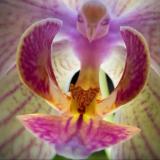

1.肥料不适
在培育它的时候,我们都是选择一些腐叶土、河沙土等等,然后把它们和少量的有机肥料混合在一起,配置成培养基质。这样它在前期会更容易活下来。然后等到每年3到10月的时候,每隔上2星期就要给它施加一次液肥,这样就可以让叶色更浓绿,如果以上这些没有做到的话,那它的营养就没有供应上,叶片发黄也是难免的。所以施肥也是要适当的。

2.湿度不适
在它生长期的时候,一定要经常保持土壤湿润,还不能让空气太干燥了,不然湿度就会降低,这样叶子也会变得无光泽,甚至枯黄。我们可以在空气干燥的时候,经常向它的叶片上喷水,来提高空气的湿度,这样就能让它的叶色浓绿。由此可见湿度也是影响叶片颜色的一个原因。

3.光照不适
它是非常害怕强光的,如果不小心让它受到强光照射,就会让叶子发黄。它一般是比较喜欢半阴环境的,而且耐阴时间很长,就算是待在阴暗地方1到2个月也是没事的。所以在平时养护它的时候,如果真的太给它晒太阳,那只能接受一些明亮的散射光。

4.浇水不适
虽说它湿润的环境,可是也不能让水分太充足了,不然就会让盆土过于湿润,造成根部溃烂,营养了植株的营养传送,进而让叶子发黄。所以浇水一定要适量,才能保持叶色浓绿。
5.病害引起
当温度极高和湿度极高时,它就会容易出现一些病害,这些病害会直接给它的植株造成影响,让其没有办法正常生长,进而也让营养缺失,导致叶子发黄,那我们就需要及时发现及时防治,防止叶子受到伤害。
0
1
文章
权问薇
2018年01月03日


繁殖的时间
这种植物主要是用种子繁殖的,一般可在10月中的时候采集种子,但是如何按断种子是否成熟呢?成熟的种子会变成紫红色,而且还会有少数果实是微裂的状态,这时候就可以进行采收了。但种子的收集实际上是比较困难的,所以也可以选择嫁接的方法,正常来说,它们在2-8月这段时间时候能嫁接的,但是尽量选择温度比较好,不冷不热的那段时间。

繁殖的方法
播种
包准备好的种子先放在室内两三天时间,这样可以让其假种皮变黑,然后再把变黑的假种皮搓掉洗净,再凉2-3天,之后还是不能直接播种,要和部分沙混合在一块保存好,但是期间也不能完全不管,要适时的补水,因为沙子是很容易变干的。到第二年3月左右,种在漏出30%的白色的时候,就可以播种了。
选择比较好的地点,先使用一次基肥,这样他们生长的最初一段时间才能不缺肥料,然后第一次要浇好水,以便生长初期能有足量的水分。
嫁接
选好枝条以后,还要选择合适的砧木,在每年雨水较多的季节过去之后,选择一个晴朗的天气,把砧木和准备好的枝条接在一块,成活的概率是很大的,几乎能达到90%以上。
就好之后一定要注意除草,还要重视一点水肥的管理,由于它们的叶片比较肥厚,所以做好每半月用一次薄肥,同时还要注意水分的控制。
0
0





